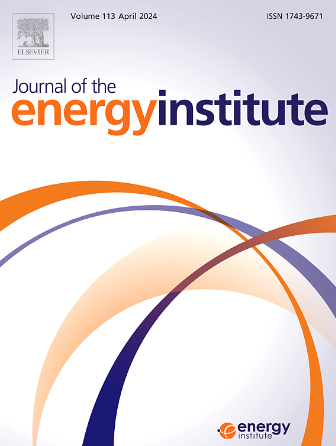Effect of ammonia blending on the emission behavior of NOx during coal combustion: A global meta-analysis
IF 6.2
2区 工程技术
Q2 ENERGY & FUELS
引用次数: 0
Abstract
Utilizing ammonia energy and fuels is crucial for advancing low-carbon power development and achieving carbon peaking and neutrality in the power sector. However, ammonia blending with pulverized coal increases NOx emissions, and the specific contributions of various factors and their mechanisms in influencing NOx generation are not well known. In this meta-analysis, 771 paired observations from 13 peer-reviewed articles were used to assess the effects of feeding properties and operating parameters of the ammonia-coal blending process on NOx formation. The results showed that the application of ammonia fuel could increase NOx emission during coal combustion, and the total emission was increased by 25.14 % compared with that of single coal combustion. Ammonia fuel's combustion ratio is the direct driver of emissions. Similarly, volatility and particle size of coal significantly affected NOx emissions. Gaseous ammonia injection, compared to liquid, typically reduced NOx due to quicker reactions and enhanced mixing. In terms of experimental scale, larger scale ammonia-coal blending tended to meet more technical challenges and thus affected the amount of NOx being produced. Simulation tests could often achieve more accurate condition control and effectively control NOx generation. CFB and BFB usually have better NOx emission control effects than PC. In addition, the air staging and excess air ratio directly affected the temperature and oxygen concentration of the combustion area, thus controlling the redox reaction during the process, but the excess air coefficient was not the greater the better. This research is expected to provide new insights for reducing carbon emissions in coal-fired power plants and promoting clean co-combustion of ammonia coal.

氨混合对煤燃烧过程中NOx排放行为的影响:一项全球荟萃分析
利用氨能源和燃料是推进电力低碳发展、实现电力行业碳调峰和中和的关键。然而,煤粉掺氨增加了NOx的排放,各种因素对NOx生成的具体贡献及其影响机制尚不清楚。在这项荟萃分析中,使用了来自13篇同行评议文章的771对观察结果,以评估氨煤混合工艺的进料特性和操作参数对NOx形成的影响。结果表明,使用氨燃料可增加煤炭燃烧过程中NOx的排放,总排放量比单一燃烧时增加25.14%。氨燃料的燃烧比是排放的直接驱动因素。同样,煤的挥发性和粒径对NOx排放也有显著影响。气态氨注入,与液体相比,通常减少氮氧化物,由于更快的反应和增强的混合。从实验规模来看,更大规模的氨煤配煤技术挑战更大,从而影响NOx的产生量。模拟试验往往可以实现更精确的工况控制,有效地控制NOx的生成。CFB和BFB通常比PC具有更好的NOx排放控制效果。此外,空气分级和过剩空气比直接影响燃烧区域的温度和氧气浓度,从而控制过程中的氧化还原反应,但过剩空气系数并不是越大越好。本研究有望为减少燃煤电厂碳排放、促进氨煤清洁共燃提供新的见解。
本文章由计算机程序翻译,如有差异,请以英文原文为准。
求助全文
约1分钟内获得全文
求助全文
来源期刊

Journal of The Energy Institute
工程技术-能源与燃料
CiteScore
10.60
自引率
5.30%
发文量
166
审稿时长
16 days
期刊介绍:
The Journal of the Energy Institute provides peer reviewed coverage of original high quality research on energy, engineering and technology.The coverage is broad and the main areas of interest include:
Combustion engineering and associated technologies; process heating; power generation; engines and propulsion; emissions and environmental pollution control; clean coal technologies; carbon abatement technologies
Emissions and environmental pollution control; safety and hazards;
Clean coal technologies; carbon abatement technologies, including carbon capture and storage, CCS;
Petroleum engineering and fuel quality, including storage and transport
Alternative energy sources; biomass utilisation and biomass conversion technologies; energy from waste, incineration and recycling
Energy conversion, energy recovery and energy efficiency; space heating, fuel cells, heat pumps and cooling systems
Energy storage
The journal''s coverage reflects changes in energy technology that result from the transition to more efficient energy production and end use together with reduced carbon emission.
 求助内容:
求助内容: 应助结果提醒方式:
应助结果提醒方式:


